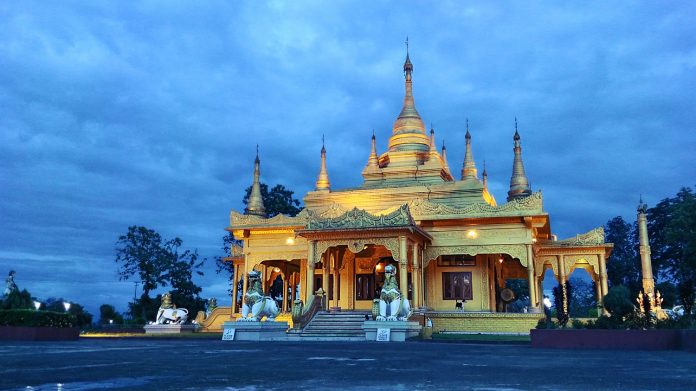Our last article dealt with the geography, polity and culture of Arunachal Pradesh and this one will be dealing with the history, environment and economy. If you haven’t read that already, click here – Know your State ‘Arunachal Pradesh’ – Part 1.
Do you know, which is the largest National Park in North-East India? Do you know through which state Brahmaputra River enters India? Under which regions McMohan Line was demarcated and what is its relevance?
Such interesting questions will be covered in the following article. So, the very first topic is –
Table of Contents
ARUNACHAL PRADESH HISTORY GK Notes
Formerly, known as NEFA (North-East Frontier Agency) from the British Colonial Era, the area was a part of Assam until it was made Indian Union Territory in 1972. Arunachal Pradesh became a state on 20 February 1987.
ANCIENT HISTORY –
- The ancient history deals with the Tani people who were found in the ancient libraries of Tibet.
- The Tani people traded swords and other metals to Tibetans in exchange for meat and wool.
- Tibetans called them Lhobas; Lho means south and bha means people.
- Apart from these groups, other Tibet-Burman groups like Mishmis, Chutias, Nocte, Tangsa and Wancho also occupied different regions of the state.
MEDIEVAL HISTORY –
- Between 500 B.C. and 600 A.D., the north-western part of this area came under the control of the Monpa Kingdom of Monyul.
- The Monpa and Sherdukpen kept the historical records of the existence of local chiefdoms in the northwest as well.
- Whereas the foothills and plains were under the control of the Chutia Kings.
- The 14th-century Malinithan was found at the foot of the Siang hills in West Siang which indicates that they were built during the Chutia reign.
- Bhimsaknagar is another notable heritage site, built in the 8th century has led to the suggestion that the Chutia people had an advanced culture and administration.
- Another very important heritage site is the 400-year-old Tawang Monastery, located in the extreme north-west of the state. It provides some historical evidence of the Buddhist tribal people. The sixth Dalai Lama Tsangyang Gyatso was born in Tawang.
McMohan Line and Sino-India War –
- The McMohan Line forms the northern boundary of the state in the eastern Himalayas administered by India but claimed by China. The area was the focus of the 1962 Sino-India War.
- This line is named after a British administrator Sir Henry McMohan at the 1914 Simla Convention. He drew the 890 km as the border between British India and Outer Tibet, placing Tawang and other areas within British India.
- The Chinese position was that Tibet was not independent of China and could not sign treaties, so the Accord was invalid, like the Anglo-Chinese (1906) and Anglo-Russian (1907) conventions.
- The North-East Frontier Agency established in 1954 was a blend of three tracts made in 1912-1913 :
- Balipara frontier tract in the west
- Sadiya frontier tract in the east
- The Abor and Mishmi hills and the Tirap frontier in the south.
- India became independent in 1947 and PRC (People’s Republic of China) was established in 1949. The new Chinese government still considered the McMohan Line invalid.
- Resurgence of the border disagreement was a factor leading to Sino-Indian relations in 1962, which led to Sino-India War. This time China captured most of Arunachal Pradesh.
- However, China soon declared victory, withdrew back to the McMohan Line and returned Indian prisoners of war in 1963.
Arunachal Pradesh is one of the Asia’s most biologically diverse and intact forests Eco-system. Arunachal Pradesh is very rich in Agro-Biodiversity having the origin of a number of plants. With this, we come to another aspect i.e.-
ARUNACHAL PRADESH ENVIRONMENT GK Notes
The environment of Arunachal Pradesh is very fascinating as it consists of such topographical and climatic conditions that favour the growth of luxuriant forests. This adds immense beauty to the area.
National Parks and Wildlife Sanctuaries –
- Namdapha National Park – This is the third largest national park in northeast India in terms of area. It is home to endangered snow leopards, red giant flying squirrel, clouded leopard, Indian leopard, Bengal tigers, red pandas and the red fox. It is located within the range of Patkai hills and the Mishmi hills, situated in Chamelang district.
- Mouling National Park – This was the second largest park to be created in the state, after Namdapha National Park in 1972. The park is named after a nearby peak with the same name which translates into “red blood”. It is home to Bengal tigers, barking deer and leopards. It is spread primarily over the Upper Siang district, and part of the West Siang and East Siang district
- Kane Wildlife Sanctuary – It is situated in the West Siang district of Arunachal Pradesh, known for the initiative aimed at preserving the wildlife of the state. Wild felines and elephants are found here.
- Mehao Wildlife Sanctuary – This wildlife sanctuary has often been described as a “real ocean of green paradise on Earth”. The sanctuary is rich in tropical forests, tigers, leopards, cats and jackals. The medicinal plants Coptis Teeta (Mishmi Teeta) is an endemic species and Taxus baccata are available here.
- Daying Erring Memorial Wildlife Sanctuary – This sanctuary is located 13 kms from Pasighat. It was established in 1978 with an area of 190 km2. It was originally established as Lali National Park.
- Dihang-Dibang Biosphere Reserve – In this biosphere reserve, Mouling National Park and Dihang Wildlife Sanctuary are situated. Key fauna includes Musk deer and Mushmi takin.
- Passes –
- Bon Di La Pass – Arunachal Pradesh with Bhutan
- Dihang Pass – Arunachal Pradesh with Myanmar
- Yonggyap Pass – Arunachal Pradesh with Tibet
- Kumjawng Pass – Arunachal Pradesh with Myanmar
- Hpungan Pass – Arunachal Pradesh with Myanmar
- Chaukan Pass – Arunachal Pradesh with Myanmar
- Brahmaputra River System –
- It origins in the Angsi glacier, located on the northern side of the Himalayas in the Burang country of Tibet as the Yarlung Tsangpo River.
- The Brahmaputra basin spreads over countries of Tibet, India, Bhutan and Bangladesh having a total area of 580,000 sq.km.
- In India, it spreads over states of Arunachal Pradesh, Assam, West Bengal, Meghalaya, Nagaland and Sikkim.
- It flows across southern Tibet to break through the Himalayas in great gorges (including the Yarlung Tsangpo Grand Canyon) and into Arunachal Pradesh.
- Tsangpo enters India after taking a U-turn at Namcha Barwa and flows in Arunachal Pradesh and here we call it Dihang River or Sihang River.
- The Lohit, the Dibang, the Subansiri, the Kameng, the Manas, the Torsa, the Sankosh and the Teesta – right bank tributaries.
- The Burhiding, the Desang, the Dikhow, the Dhansiri and the Kopili – left bank tributaries.
- It flows southwest through the Assam valley as Brahmaputra and south through Bangladesh as the Jamuna in the vast Ganges Delta, it merges with the Padma, the popular name of the river Ganges in Bangladesh, and finally the Meghna and from here it is known as Meghna before emptying into the Bay of Bengal.
- The state is divided into 5 river valleys –
- Kameng
- Subansiri
- Siang
- Lohit
- Tirap
- Arunachal’s forests account for one-third of the habitat area within the Himalayan biodiversity hot-spot.
- According to tribal beliefs in Arunachal Pradesh, dense forests and big trees are looked upon as ancestral souls, and hornbill hunting is banned during the breeding season. The tiger is sacred as it is the “brother of Tani, the first human on Earth”.
Let’s come to another aspect –
ARUNACHAL PRADESH ECONOMY GK Notes
The following information will provide us with the information related to the economy of Arunachal Pradesh –
- At current prices, the GSDP (Gross State Domestic Product) of Arunachal Pradesh was Rs. 280.52 lakh crore in 2019-20.
- The state’s GSDP increased at a compound annual growth rate of 12.33% between 2011-12 and 2019-20.
- The state economy is largely agrarian, based on the terraced farming of rice and the cultivation of crops such as maize, millet, wheat, pulses, sugarcane, ginger, oilseeds, cereals, potato and pineapple.
- Construction of the Upper Siang Hydroelectric Project, which is expected to generate between 10,000 and 12,000 MW, began in April 2009.
- Some of the policies which offer huge fiscal and policy incentives for the development of thrust sectors in the state are Public-Private Partnership Policy 2011, the State Industrial Policy 2008 and the Hydro Power Policy 2008.
- As of February 2008, Arunachal Pradesh had a total installed power generation capacity of 378.64 MW, comprising 158.05 from hydro, 136.72 MW from renewable energy sources (RES) and 83.87 MW from thermal.
- The state is the largest producer of Kiwis in India and the second largest of large Cardamom. The state also has various inland fisheries.
- Under the “North-East Region Textile Promotion Scheme”, 24 sericulture projects are implemented for the holistic development of sericulture in the state.
ARUNACHAL PRADESH EDUCATION GK Notes
The average literacy rate in the state is 66.95% according to the 2011 census. Education in Arunachal Pradesh is gradually improving several plans and projects being initiated by both state and central government.
- NERIST (North Eastern Regional Institute of Science and Technology) plays a very significant role in raising the technical and management education in the state.
- The institutions of higher education in Arunachal Pradesh are: Indira Gandhi Technological and Medical Sciences University and Himalayan University. They are established under the UGC act 1956 section 2f and with Arunachal Pradesh Assembly Gazette approval.
- Tomo Riba Institute of Health and Medical Sciences (TRIHMS) is the first medical college in the state which was made operationalised. The college received its first batch of 50 MBBS students in 2018. In the state budget 2019-20, Rs. 90 crore and Rs. 40 crore were proposed to provide as Grants-in-Aid for smooth running of the hospital and medical college.
- Rajiv Gandhi University is the oldest university in the Indian state of Arunachal Pradesh. It is located in the Rono Hills of Doimukh village, about 9 miles from the state capital, Itanagar. The foundation stone for the university was laid in 1984 by then-Prime Minister Indira Gandhi.
ARUNACHAL PRADESH SPORTS GK Notes
Sports play a very significant role in people’s lives. Some of the sports of Arunachal Pradesh are –
- Hole Taso Dukanaram – This is a game which involves the imitation of an animal called Hole Taso. The animal quite like a cat runs around beating its chest alternatively with both its front paws.
- Hinam Turnam – This game is called the struggle of life and death by local people. The participants here in the game assume the role of the hunter and the hunted in the forest.
- Majong – This is a traditional game played by four persons with small tiles where the players pick up the tiles and discard them until any one of them has a winning combination.
- Archery – It is also a prominent sport of Arunachal Pradesh. It is not only an important sport but people look upon it as a part of their culture.
- Football – The Arunachal Pradesh Football Association is the governing body of football activities in the state which is gradually gaining popularity.
Here are some interesting facts about Arunachal Pradesh –
- Tapi Mra – A mountaineer from India and the first person from Arunachal Pradesh to scale Everest.
- Arunachal Pradesh, meaning “Land of the Rising Sun”, long has been a recognized region of the Indian subcontinent, receiving mention in such ancient Hindu literature as the Kalika-Purana, the epic poems, Mahabharat and Ramayana.
- Kiren Rijiju, the current minister of State of the Ministry of Youth Affairs and Sports and Minister of State in the Ministry of Minority Affairs of India, is from Arunachal Pradesh.
- Length of the international boundary of Arunachal Pradesh is 1817 km which is third longest of Indian states lying on international borders.
- Arunachal Pradesh has the second largest decadal population growth rate of 25.9%, first being Meghalaya with 27.8%.
- Mrinal Miri is a popular philosopher who graduated from the University of Cambridge.
- Dorjee Khandu is the former Chief Minister of Arunachal Pradesh who belongs to Congress Party. He succumbed in a helicopter accident in 2011.
This was all about this state. We’ll keep informing you about the significance and beauty of each state/UT just like this. In the next blog, we would be discussing some interesting facts and trivia about the state of Assam. Click here for Know your State – ‘Assam’. Hope this helps you in preparing for your competitive exams such as CDS, SSC CGL, NET JRF, etc.
Did you know that the seven states of Northeast India are called sister states? This is because they are all interdependent on one another and are connected to the rest of the country through the Siliguri Corridor. To find out interesting information about each of these states, click on the links given below.
Know your State ‘Assam’
Know your State ‘Meghalaya’
Know your State ‘Mizoram’
Know your State ‘Nagaland’
Know your State ‘Manipur’
Know your State ‘Tripura’
Thank You




